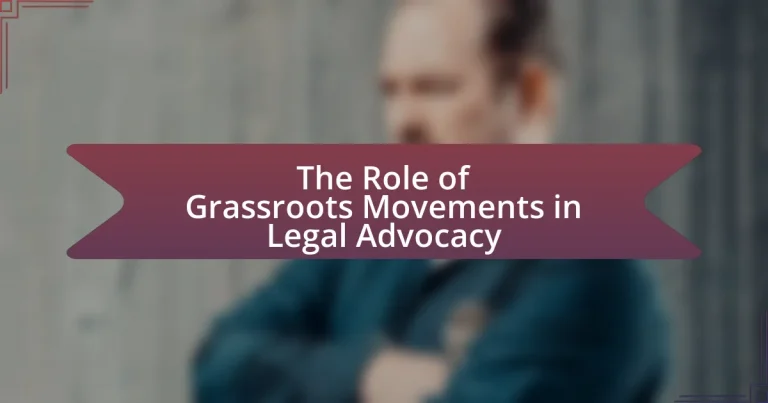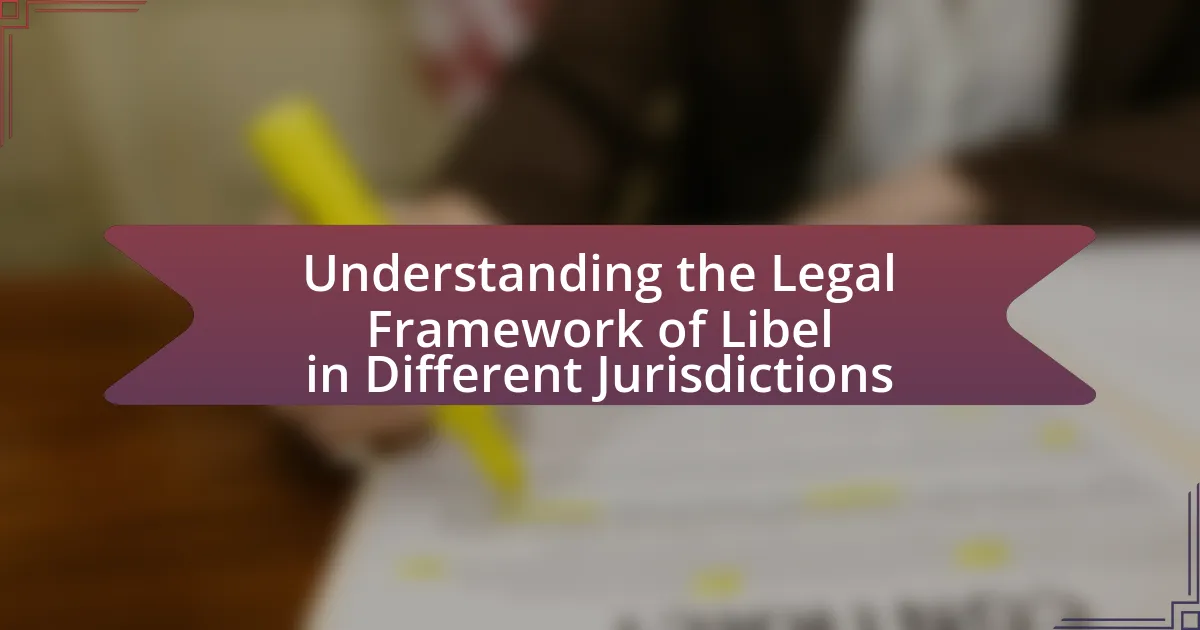Grassroots movements in legal advocacy are organized efforts by individuals and communities aimed at influencing legal and policy changes in response to social injustices. These movements utilize strategies such as community mobilization, coalition-building, and public awareness campaigns to advocate for reforms that reflect public needs. The article explores how grassroots movements have historically impacted legal change, exemplified by the Civil Rights Movement, and discusses the challenges they face, including limited resources and access to legal expertise. Additionally, it highlights best practices for effective advocacy, emphasizing the importance of community engagement and collaboration with legal professionals to achieve significant legal outcomes.
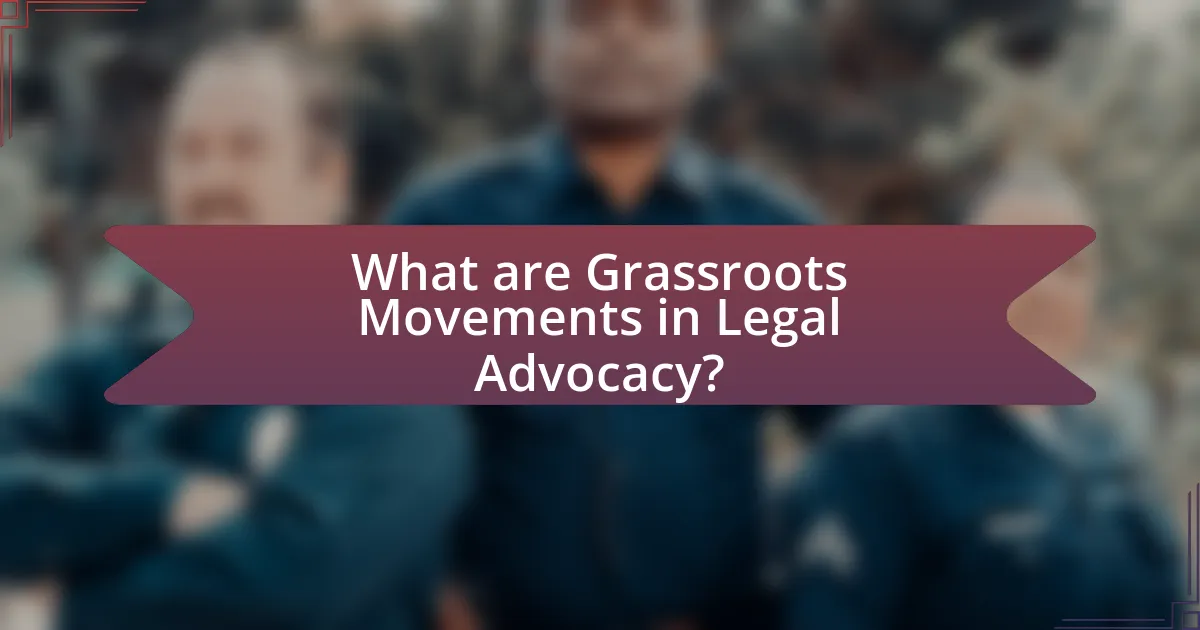
What are Grassroots Movements in Legal Advocacy?
Grassroots movements in legal advocacy are organized efforts by ordinary individuals or communities to influence legal and policy changes at local, state, or national levels. These movements often arise in response to social injustices or legal inequities, mobilizing citizens to advocate for their rights and push for reforms. For example, the Civil Rights Movement in the United States, which sought to end racial segregation and discrimination, exemplifies how grassroots activism can lead to significant legal changes, such as the Civil Rights Act of 1964. Grassroots movements leverage community engagement, public awareness campaigns, and coalition-building to amplify their voices and effectuate legal change.
How do grassroots movements influence legal change?
Grassroots movements influence legal change by mobilizing community support and advocating for policy reforms that reflect the needs and desires of the public. These movements often raise awareness about specific issues, such as civil rights or environmental protection, which can lead to increased public pressure on lawmakers. For instance, the Civil Rights Movement in the 1960s successfully pushed for the Civil Rights Act of 1964 and the Voting Rights Act of 1965 through organized protests and grassroots advocacy, demonstrating how collective action can lead to significant legal reforms. Additionally, grassroots movements utilize social media and grassroots organizing to amplify their messages, making it easier to gather support and influence public opinion, which in turn can sway legislative agendas.
What strategies do grassroots movements employ in legal advocacy?
Grassroots movements employ strategies such as community mobilization, coalition building, and public awareness campaigns in legal advocacy. Community mobilization involves organizing local individuals to participate in advocacy efforts, which enhances collective power and influence. Coalition building brings together diverse groups to strengthen their legal positions and share resources, exemplified by the collaboration between environmental and social justice organizations in landmark cases. Public awareness campaigns utilize media and social platforms to educate the public and policymakers about legal issues, effectively shaping public opinion and driving legislative change, as seen in movements advocating for criminal justice reform. These strategies collectively empower grassroots movements to challenge legal injustices and advocate for systemic change.
How do grassroots movements mobilize community support for legal issues?
Grassroots movements mobilize community support for legal issues by fostering local engagement and raising awareness through direct action and education. These movements often utilize social media platforms to disseminate information quickly, organize events, and create networks of support, which can lead to increased participation in advocacy efforts. For instance, the Black Lives Matter movement effectively mobilized community support for legal reforms by organizing protests and leveraging social media to highlight issues of racial injustice, resulting in significant public discourse and policy changes. This approach demonstrates how grassroots movements can effectively galvanize community involvement and influence legal outcomes.
Why are grassroots movements important in the legal landscape?
Grassroots movements are important in the legal landscape because they mobilize community members to advocate for legal reforms and social justice. These movements often highlight issues that may be overlooked by traditional legal systems, bringing attention to injustices and influencing public policy. For example, the Civil Rights Movement in the United States, which began as a grassroots effort, led to significant legal changes such as the Civil Rights Act of 1964 and the Voting Rights Act of 1965. This demonstrates how grassroots activism can effectively challenge existing laws and promote legal advancements that reflect the needs and rights of marginalized communities.
What role do grassroots movements play in raising awareness of legal issues?
Grassroots movements play a crucial role in raising awareness of legal issues by mobilizing community members to advocate for change and educate the public. These movements often highlight specific legal injustices, such as discrimination or environmental concerns, through campaigns, protests, and social media outreach. For instance, the Black Lives Matter movement has significantly increased awareness of police brutality and systemic racism, leading to widespread discussions and legislative proposals aimed at reforming law enforcement practices. Additionally, grassroots organizations often provide resources and support to individuals affected by legal issues, thereby fostering a more informed and engaged citizenry. This engagement can lead to increased pressure on policymakers to address these issues, demonstrating the effectiveness of grassroots efforts in shaping legal discourse and promoting social justice.
How do grassroots movements challenge existing legal frameworks?
Grassroots movements challenge existing legal frameworks by mobilizing community members to advocate for policy changes that reflect their needs and values. These movements often highlight gaps or injustices within the legal system, using tactics such as protests, petitions, and social media campaigns to raise awareness and pressure lawmakers. For instance, the Civil Rights Movement in the United States effectively challenged discriminatory laws by organizing mass protests and legal challenges, leading to significant legislative changes like the Civil Rights Act of 1964. This demonstrates how grassroots activism can directly influence legal reforms by amplifying marginalized voices and demanding accountability from governing bodies.
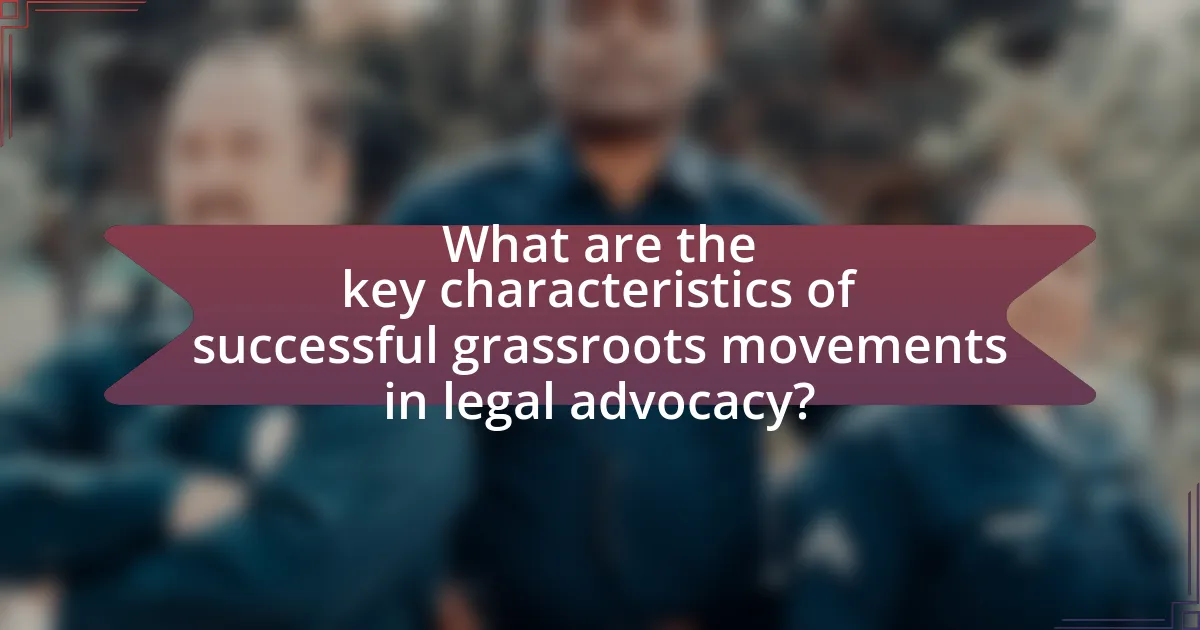
What are the key characteristics of successful grassroots movements in legal advocacy?
Successful grassroots movements in legal advocacy are characterized by strong community engagement, clear messaging, and strategic coalition-building. Community engagement fosters a sense of ownership and mobilizes individuals to participate actively, as seen in movements like the Civil Rights Movement, where local communities played a pivotal role in organizing protests and legal challenges. Clear messaging ensures that the goals and demands of the movement resonate with a broader audience, exemplified by the Women’s March, which effectively communicated issues of gender equality and social justice. Strategic coalition-building allows diverse groups to unite for a common cause, enhancing the movement’s reach and impact, as demonstrated by the collaboration between environmental and social justice organizations during the fight against climate change. These characteristics collectively contribute to the effectiveness and sustainability of grassroots movements in achieving legal reforms.
What factors contribute to the effectiveness of grassroots movements?
The effectiveness of grassroots movements is primarily influenced by community engagement, clear messaging, and strategic organization. Community engagement fosters a sense of ownership and commitment among participants, which enhances mobilization efforts. For instance, the Civil Rights Movement in the United States gained momentum through local involvement, leading to significant legislative changes. Clear messaging ensures that the movement’s goals resonate with a broader audience, as seen in the Women’s March, which effectively communicated issues of equality and justice. Strategic organization, including the use of social media for outreach and coordination, has been pivotal in recent movements like Black Lives Matter, allowing for rapid response and adaptation to changing circumstances. These factors collectively contribute to the ability of grassroots movements to effect change and influence legal advocacy.
How does leadership impact the success of grassroots legal advocacy?
Leadership significantly impacts the success of grassroots legal advocacy by providing direction, motivation, and strategic vision. Effective leaders mobilize community members, build coalitions, and foster a sense of ownership among participants, which enhances engagement and commitment to advocacy goals. For instance, research by the National Council of Nonprofits highlights that strong leadership correlates with increased organizational effectiveness and community trust, leading to more successful advocacy outcomes. Furthermore, leaders who possess legal expertise can navigate complex legal frameworks, ensuring that grassroots efforts align with legal standards and maximize their impact.
What role does community engagement play in grassroots movements?
Community engagement is essential in grassroots movements as it fosters collective action and mobilizes individuals towards a common goal. This engagement allows community members to share their experiences, identify shared issues, and develop strategies for advocacy. For instance, the Civil Rights Movement in the United States exemplified how community engagement galvanized local populations to challenge systemic injustices, leading to significant legal reforms such as the Civil Rights Act of 1964. By actively involving community members, grassroots movements can build trust, enhance participation, and create a sense of ownership over the advocacy process, ultimately increasing their effectiveness in achieving legal and social change.
How do grassroots movements collaborate with legal professionals?
Grassroots movements collaborate with legal professionals by engaging them in advocacy efforts to address social justice issues. These collaborations often involve legal professionals providing pro bono legal services, advising on legal strategies, and helping to draft legislation or policy proposals that align with the movement’s goals. For instance, organizations like the American Civil Liberties Union (ACLU) frequently partner with grassroots groups to amplify their legal challenges against unjust laws, demonstrating the effectiveness of such collaborations in achieving tangible legal outcomes.
What benefits arise from partnerships between grassroots movements and legal experts?
Partnerships between grassroots movements and legal experts enhance advocacy effectiveness and broaden access to justice. Grassroots movements bring community insights and mobilization capabilities, while legal experts provide essential knowledge of laws and legal processes. This collaboration can lead to more informed strategies, increased public awareness, and stronger legal arguments. For instance, the partnership between the NAACP and legal professionals during the Civil Rights Movement resulted in landmark Supreme Court cases, such as Brown v. Board of Education, which dismantled racial segregation in public schools. Such historical examples demonstrate that these partnerships can yield significant legal victories and social change.
How can grassroots movements effectively communicate their legal needs to lawyers?
Grassroots movements can effectively communicate their legal needs to lawyers by clearly articulating specific issues and desired outcomes through organized channels. This involves preparing concise documentation that outlines the legal challenges faced, the context of these challenges, and the support required from legal professionals. For instance, successful grassroots campaigns often utilize surveys or focus groups to gather data on community legal needs, which can then be presented to lawyers to illustrate the urgency and importance of the issues. Additionally, establishing regular communication through meetings, emails, or collaborative platforms fosters ongoing dialogue, ensuring that lawyers are kept informed and engaged with the grassroots movement’s objectives.
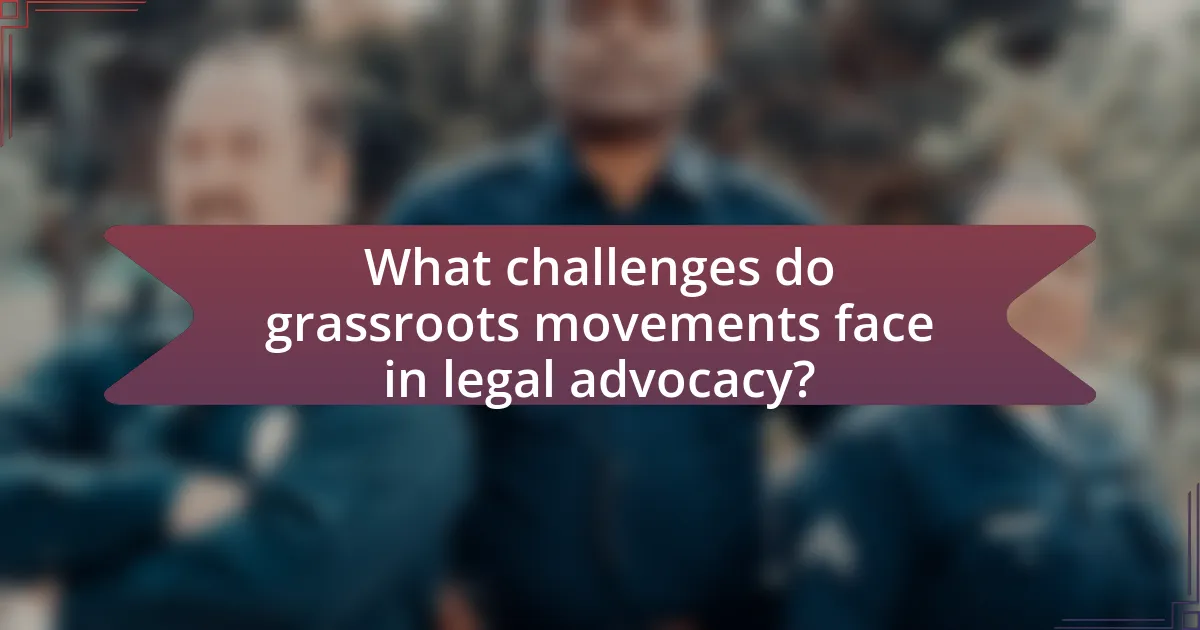
What challenges do grassroots movements face in legal advocacy?
Grassroots movements face significant challenges in legal advocacy, primarily due to limited resources and access to legal expertise. These movements often operate on tight budgets, which restricts their ability to hire experienced legal professionals or fund extensive litigation efforts. For instance, a study by the National Lawyers Guild highlights that many grassroots organizations struggle to compete with well-funded opponents, such as corporations or government entities, which can afford extensive legal representation. Additionally, grassroots movements may encounter difficulties in navigating complex legal systems, as they often lack the necessary training or knowledge to effectively advocate for their causes. This combination of financial constraints and a lack of legal acumen can severely hinder their ability to influence policy or achieve desired legal outcomes.
What obstacles hinder the progress of grassroots legal initiatives?
Grassroots legal initiatives face several obstacles that hinder their progress, including limited funding, lack of access to legal resources, and bureaucratic resistance. Limited funding restricts the ability of grassroots organizations to sustain operations, conduct outreach, and provide necessary legal services. According to a report by the National Council of Nonprofits, 70% of nonprofits cite funding as a significant barrier to achieving their missions. Additionally, grassroots movements often struggle to access legal expertise and resources, which can impede their effectiveness in navigating complex legal systems. Bureaucratic resistance from government entities can further complicate efforts, as regulations and policies may not favor grassroots advocacy, leading to delays and obstacles in implementing initiatives.
How do funding limitations affect grassroots movements in legal advocacy?
Funding limitations significantly hinder grassroots movements in legal advocacy by restricting their ability to mobilize resources, conduct outreach, and sustain operations. Without adequate financial support, these movements struggle to hire legal experts, engage in public education campaigns, and cover essential costs such as litigation fees. For instance, a study by the National Council of Nonprofits highlights that organizations with limited funding often face challenges in maintaining staff and resources necessary for effective advocacy, leading to diminished impact on policy change. Consequently, funding constraints can result in reduced visibility and influence in legal matters, ultimately undermining the goals of grassroots movements.
What strategies can grassroots movements use to overcome legal challenges?
Grassroots movements can overcome legal challenges by employing strategies such as coalition-building, legal education, and strategic litigation. Coalition-building allows grassroots organizations to unite diverse groups, amplifying their collective voice and resources, which can lead to increased political pressure and legal support. Legal education empowers community members with knowledge about their rights and the legal system, enabling them to navigate challenges more effectively. Strategic litigation involves selecting specific cases that can set legal precedents or draw public attention to broader issues, thereby influencing policy changes. For instance, the NAACP’s legal strategy in the Brown v. Board of Education case exemplifies how targeted litigation can dismantle systemic barriers.
How can grassroots movements sustain momentum in their advocacy efforts?
Grassroots movements can sustain momentum in their advocacy efforts by fostering community engagement and leveraging social media for outreach. Engaging community members through regular meetings, events, and collaborative projects creates a sense of ownership and commitment among participants. For instance, the Black Lives Matter movement effectively utilized social media platforms to mobilize supporters, share information, and amplify their message, resulting in widespread participation and sustained advocacy efforts. Additionally, maintaining clear communication and transparency about goals and progress helps to keep supporters informed and motivated, as seen in successful campaigns like the Fight for $15, which consistently updated its followers on legislative developments and organized actions.
What role does social media play in maintaining grassroots advocacy efforts?
Social media serves as a crucial tool for maintaining grassroots advocacy efforts by facilitating communication, mobilization, and awareness. It enables grassroots organizations to reach a wider audience quickly, allowing them to share information, rally support, and organize events effectively. For instance, platforms like Twitter and Facebook have been instrumental in campaigns such as the Women’s March, which mobilized millions globally through social media outreach. Additionally, studies show that social media can increase engagement and participation in advocacy efforts, with 69% of adults in the U.S. using social media to connect with others who share their interests, including social causes. This connectivity fosters a sense of community and collective action, essential for sustaining grassroots movements.
How can grassroots movements measure their impact on legal change?
Grassroots movements can measure their impact on legal change through quantitative metrics such as changes in legislation, the number of petitions signed, and the level of public engagement. For instance, the successful passage of laws often correlates with organized campaigns that mobilize community support, as seen in the legalization of same-sex marriage in various states, where grassroots advocacy played a crucial role. Additionally, qualitative assessments, such as surveys and interviews with stakeholders, can provide insights into shifts in public opinion and awareness resulting from grassroots efforts. These methods collectively demonstrate the effectiveness of grassroots movements in influencing legal frameworks and societal norms.
What best practices can grassroots movements adopt for effective legal advocacy?
Grassroots movements can adopt several best practices for effective legal advocacy, including building coalitions, engaging in community education, and utilizing strategic litigation. Building coalitions with other organizations enhances resources and amplifies voices, as seen in the collaboration between the NAACP and other civil rights groups during the 1960s, which significantly advanced legal reforms. Engaging in community education empowers individuals with knowledge about their rights and legal processes, fostering informed participation in advocacy efforts. Additionally, utilizing strategic litigation, as demonstrated by the ACLU in landmark cases like Brown v. Board of Education, can create significant legal precedents that benefit broader communities. These practices collectively strengthen grassroots movements’ capacity to influence legal outcomes and promote social justice.
How can grassroots movements build a strong coalition for legal change?
Grassroots movements can build a strong coalition for legal change by fostering inclusive participation, establishing clear goals, and leveraging community resources. Inclusive participation ensures diverse voices are heard, which strengthens the coalition’s legitimacy and broadens its support base. Establishing clear goals aligns the coalition’s efforts, making it easier to mobilize resources and advocate effectively. Leveraging community resources, such as local organizations and networks, enhances the coalition’s capacity to influence legal change by providing necessary support and expertise. Historical examples, such as the Civil Rights Movement, demonstrate that coalitions formed through these strategies can successfully challenge and change unjust laws.
What are the key steps for grassroots movements to develop a successful advocacy campaign?
Grassroots movements can develop a successful advocacy campaign by following key steps: defining a clear goal, building a coalition, engaging the community, creating a strategic plan, and utilizing effective communication.
Defining a clear goal involves identifying the specific issue to address and the desired outcome, which provides direction for the campaign. Building a coalition entails gathering diverse stakeholders who share the same vision, enhancing the movement’s strength and reach. Engaging the community is crucial for mobilizing support and ensuring that the campaign reflects the needs and voices of those affected. Creating a strategic plan includes outlining actionable steps, timelines, and resource allocation to guide the campaign’s execution. Finally, utilizing effective communication strategies, such as social media and public events, helps to raise awareness, attract supporters, and influence decision-makers.
These steps are supported by successful examples, such as the Civil Rights Movement, which effectively mobilized grassroots support through clear goals and community engagement, leading to significant legislative changes.
